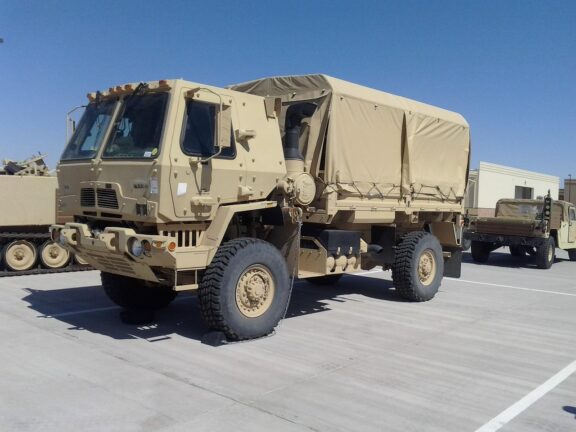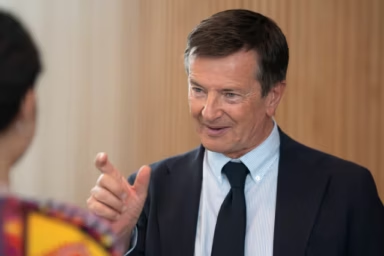Europe is moving towards its first-ever ‘Military Schengen’ — a system designed to let troops, equipment and military assets cross the continent far faster than they do today. The goal is to meet rising security pressures and remove the bottlenecks that could slow a response to potential threats, as intelligence services warn Russia could be in a position to target an EU and NATO member by 2030.
In Brussels, the European Commission and the High Representative unveiled a new military mobility package alongside a Defence Industry Transformation Roadmap — the most far-reaching update of Europe’s defence posture in decades. The move follows Russia’s continued aggression against Ukraine, drone incursions inside EU country borders, and – most recently – alleged sabotage of railway tracks in Poland (which has led Poland’s foreign minister to shut down Russia’s last consulate in Gdańsk in response, calling the act “state terror). Russia denies any rile in the sabotage and has denied any intention to attack Europe in the future, but recent operations appear to tell a different story.
After the College meeting, High Representative Kaja Kallas called Russia’s activities “increasingly brazen”, warning that Europe needed to move much faster.
“It’s quite simple,” she said, “the faster we can move forces, the stronger our deterrence and defence. We need to be talking about days and not weeks to move troops in Europe. Some countries still require 45 days’ notice before other countries’ troops can pass through for exercises… Eleven years after Russia annexed Crimea, this is simply not good enough.”
You might be interested
2027 deadline
The Commission wants an EU-wide military mobility area in place by 2027. The plan would replace the patchwork of national procedures with a single set of EU rules, cut approval times for troop movements to three days, and upgrade key routes so they can handle military transport in a crisis.
Commissioner Andrius Kubilius said the shift to a legally binding Regulation marked a significant break with past practice. “Speed is a cornerstone of defence and deterrence… we need to speak about minutes and hours and not days and weeks like we have until now,” he said.
He stressed that, for the first time, the EU is proposing a regulation — not just a strategy — replacing 27 national permit systems with a single union-wide procedure. A new emergency framework will govern military mobility in a crisis, and it urges member states to pool and share key capabilities.
Transport Commissioner Apostolos Tzitzikostas stressed the role of infrastructure, with key sections being revamped or upgraded as opposed to newly introduced:
“The time to prepare is not when the crisis hits. It is now. Logistics networks can make the difference between winning and losing wars… When you want to defend a continent, you must be able to move across it.”
What the package does
The new rules introduce the first EU-level procedures for military mobility, streamline customs and border requirements. A new emergency system — EMERS — will give EU or NATO missions fast-track access to priority corridors during crises.
Key transport routes will be upgraded to dual-use standards, supported by a resilience toolbox for cybersecurity, energy security and crisis response. Member states will also be able to pool transport capacity through a Solidarity Pool, backed by stronger coordination structures including a Military Mobility Transport Group and national military transport coordinators.
The faster we can move forces, the stronger our deterrence and defence. We need to be talking about days and not weeks to move troops in Europe. – Kaja Kallas, High Representative of the Union for Foreign Affairs and Security Policy
Modernising Europe’s defence industry
The Defence Industry Transformation Roadmap aims to speed up innovation and production by linking deep-tech firms with established defence suppliers and supporting technologies such as AI, quantum systems, drones and space assets. It also focuses on investment, access to next-generation capabilities, and the workforce needed to maintain Europe’s technological edge.
Russia’s war in Ukraine has shown how quickly battlefield technology evolves; EU officials say Europe must adapt just as quickly.
The time to prepare is not when the crisis hits. It is now… When you want to defend a continent, you must be able to move across it. – Apostolos Tzitzikosta, Commissioner of Transport and Logistics

Context and urgency
Both initiatives deliver commitments made in the White Paper for European Defence – Readiness 2030 and the ReArm Europe Plan, and were designed with the EEAS and EDA to ensure compatibility with NATO. Commissioner Kubilius warned on Wednesday that concerns about urgency were anything but misplaced:
“If I were predicting [a Russian attack] myself, maybe not everyone would believe me. But when the intelligence services are saying it, it’s really serious.”
He said EU support — around €17bn — does not remove member states’ responsibility to prepare, noting recent cross-border fast-lane agreements involving Poland, Germany and the Netherlands.
In outlining the regulation, he added:
“The military mobility regulation in the package proposes ways to substantially reduce bureaucratic burden and timeframes for military troops movement and offers new solutions for the dual use mobility assets accessibility at scale when will be needed. This is how we turn industrial strength into operational readiness — and make sure Europe can move as one, with the speed and coordination of our security demands.
If I were predicting it myself, maybe not everyone would believe me. But when the intelligence services are saying it, it’s really serious. – Andrius Kubilius, Commissioner for Defence and Space
The military mobility Regulation now goes to the Council and European Parliament for adoption. The Commission will begin implementing the Defence Industry Roadmap immediately.





